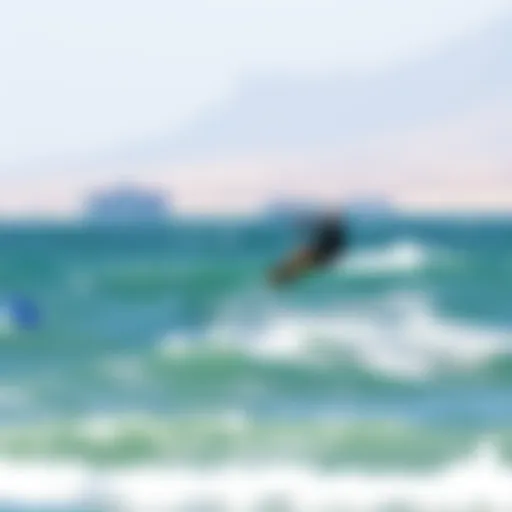Expert Kitesurfing Lessons in West Palm Beach
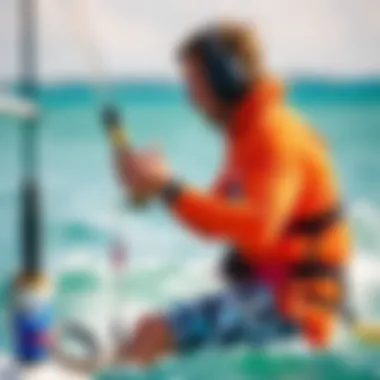
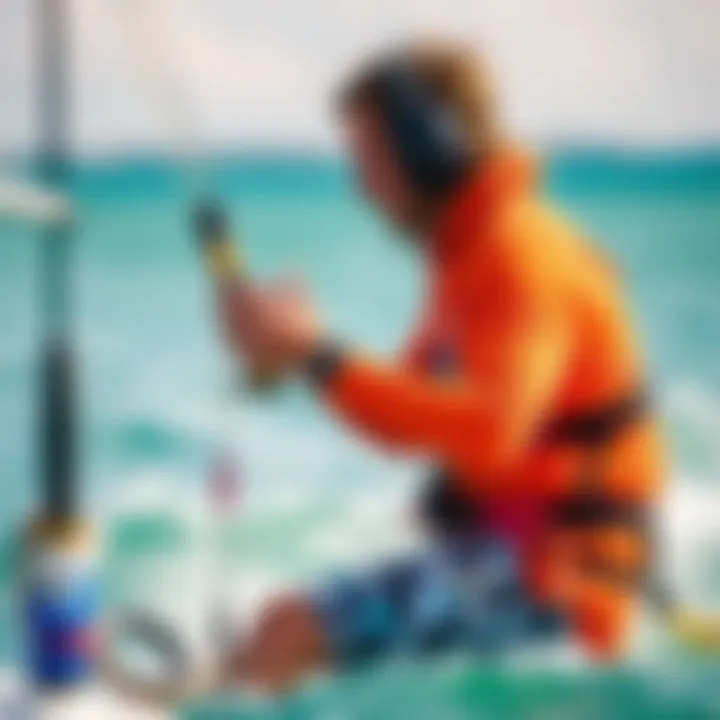
Intro
Kitesurfing is a captivating blend of surfing, sailing, and flying. This adrenaline-pumping sport not only provides an exhilarating way to experience the water, but it also fosters a strong community among enthusiasts. As one stands on the sandy shores of West Palm Beach, it’s hard to resist the allure of those colorful kites dancing majestically in the wind, each telling a story of adventure and skill.
In this guide, we’ll embark on an exploration of kitesurfing lessons in West Palm Beach. From understanding what gear to bring along, to honing your skills and embracing local culture, this comprehensive narrative touches all bases, ensuring that both novices and experienced riders understand what this vibrant sport is all about. So, whether you are eager to dip your toes into kitesurfing for the first time or are planning to refine your technique, you’ll find everything you need to make the most of your journey along the sunny shores of Florida.
Gear Selection
Choosing the right equipment can make or break your kitesurfing experience. The right gear not only enhances performance but also ensures safety while you ride the waves. Here's a closer look at the essentials every kitesurfer should consider.
Types of Kites
Kitesurfing kites can be classified mainly into two categories: inflatable kites and foils.
- Inflatable Kites: These are popular among beginners for their ease of use. They are robust, stable, and designed to lift you off the water swiftly. Their structure provides a forgiving nature, making them a frequent choice in lessons.
- Foil Kites: These kites are often favored by more advanced riders. They offer higher performance and efficiency, especially in lighter winds. However, they can be trickier to handle, requiring a bit of experience to navigate.
Each type of kite has its own attributes, and beginners should consult with instructors to find the one that suits their learning style.
Choosing the Right Board
Board selection can be just as critical as picking your kite. There are primarily two types of boards: directional and twin-tip.
- Directional Boards: These boards resemble surfboards and are great for riding with the wind. They are perfect for those who want to ride waves, providing a responsive and exhilarating experience as you carve through the water.
- Twin-Tip Boards: They are more common for beginners and are designed for riding in both directions. Their versatility allows newbies to practice turning and jumping without needing to switch boards. They’re user-friendly and often come recommended for those taking lessons.
While kites and boards are fundamental, it’s also crucial to invest in proper harnesses, helmets, and safety gear. Ensuring comfort and safety will enable you to focus on learning rather than worrying about your setup.
Skill Development
Once you've selected your gear, the next step is to immerse yourself in skill development. Kitesurfing isn't just about having the right tools; it’s also about learning how to use them effectively.
Essential Techniques
Understanding the basic techniques is vital for success. Lessons typically begin with land training to familiarize students with kite control. This involves practicing movements such as:
- Launching and Landing: Mastering these is essential for safety.
- Body Dragging: This technique helps you learn how to maneuver the kite in the water while you're being pulled.
- Water Start: The culmination of your training, this is where you will learn to get up on the board and ride.
These foundational skills will enhance your confidence and set you up for more advanced maneuvers in the future.
Progression Tips
After grasping the essentials, kitesurfers often seek ways to progress their skills. Some tips for effective progression include:
- Practice Regularly: Consistency is key. A little time on the water each week helps build muscle memory.
- Take Feedback Seriously: Listen to your instructors’ advice and incorporate those suggestions into your practice sessions.
- Set Personal Goals: Assess your skills and aim for specific achievements, whether that be more complex tricks or longer rides.
- Join a Community: Surrounding yourself with fellow kitesurfers can motivate you to keep pushing and can offer invaluable learning opportunities.
Be sure to soak in the local culture and events as well. West Palm Beach frequently hosts kitesurfing competitions, offering opportunities to learn from seasoned riders.
As you prepare for your kitesurfing lessons, it’s vital to embrace the journey ahead, blending safety with enjoyment. The ocean awaits, calling you to its waves as you embark on your kitesurfing adventure.
Understanding Kitesurfing
Kitesurfing is more than just a sport; it's a thrilling blend of surfing and flying. Understanding kitesurfing is essential, as it sets the foundation for everything that follows in your journey as a kiteboarder. This article will explore the practical and technical aspects of kitesurfing, and why grasping the core elements enhances not just your skills but your enjoyment of the experience.
Definition and History
Kitesurfing is defined as a water sport that utilizes a large steerable kite to pull a rider across the water on a small board. The idea is rather simple, yet the sensations and skills involved are anything but. This sport sprouted from the minds of innovators in the 1960s and found its legs in the 1990s, when a few daring individuals began experimenting with kites on surfboards. It has since evolved into a full-fledged sport, with competitions and a vibrant community that stretches across the globe.
That's quite a transformation from its early days of simply having fun on the water with a homemade kite. The sport has roots in various cultures, with different forms of kite surfing existing long before it reached Western shores. Today's kitesurfing combines elements of aerial acrobatics, surfing, and boardsports, set against picturesque backdrops like West Palm Beach—all key to its appeal. The connection with nature, the thrill of riding the wind, and the rush of conquering waves create an exhilarating experience.
Kitesurfing Dynamics
Now, diving into the nitty-gritty, understanding the dynamics of kitesurfing is crucial. At the heart of this sport is the relationship between the rider, the kite, and the wind. Here’s a simple breakdown of these crucial elements:
- The Kite: Various types of kites, like inflatable kites and foil kites, serve different purposes. For instance, beginner kites are designed for stability, while advanced kites offer agility and speed.
- The Wind: Wind speed and direction play pivotal roles in how you maneuver the water. A good understanding of weather conditions can dramatically enhance your riding experience. Common wind patterns in West Palm Beach make it a prime location for kitesurfing.
- The Board: Riders choose from twin-tips, directional boards, and more based on the conditions and their skills. Each board offers a unique feel and requires distinct riding techniques.
In essence, the interplay of these factors creates a dynamic environment where learning and improvement happen quickly. Grasping the intricacies of kitesurfing can lead to greater enjoyment and a safer experience. The thrill lies in mastering these dynamics, enabling a seamless dance with the wind and waves.
"Before every thrilling ride, there’s a learning curve that elevates every moment on the water."
Understanding these basic elements not only makes the learning process smoother but also enriches your appreciation for the sport as a whole.
As you embark on your kitesurfing adventure, remember that this sport, while exhilarating, comes with its intricacies and demands respect and understanding. Each day on the water is a new opportunity to learn and improve, making knowledge of kitesurfing crucial for every aspiring kiteboarder.
Kitesurfing Lessons Overview
Kitesurfing is not just a sport; it's truly a lifestyle that draws people to the water's edge. In this section, we highlight the pivotal role lessons play in mastering this thrilling experience. Enrolling in kitesurfing lessons is essential for several reasons, making it a cornerstone for anyone looking to carve through the waves and float on the winds in West Palm Beach.
Why Lessons are Essential
Jumping right into kitesurfing without proper guidance is like throwing a dart in the dark; often, you’ll miss your target completely. Here are some of the key reasons why taking lessons should be your first step:
- Safety First: Kitesurfing comes with its share of risks, from erratic winds to equipment failure. Professional instructors teach you about these risks and how to mitigate them.
- Skill Development: A structured lesson plan tackles everything from basic maneuvers to advanced tricks, ensuring systematic growth in skills.
- Equipment Understanding: Knowing your gear is half the battle. Lessons provide you with hands-on experience in how to set up and maintain your equipment, enhancing your confidence while out on the water.
- Local Knowledge: Each kitesurfing spot has its own quirks. Learning from local experts provides insights into the best conditions, potential hazards, and hidden gems of West Palm Beach.
Taking a lesson not only protects you but enriches your kitesurfing experience through informed practices. Without them, a great day on the water can quickly turn into a learning experience you didn’t bargain for.
What to Expect from a Lesson
When you decide to lace up your kite shoes and hit the water, understanding what a lesson entails can help demystify the process:
- Theory Instruction: Before stepping into the water, expect a good dose of theory, covering wind direction, equipment functioning, and safety protocols.
- Hands-On Practice: Instructors will guide you through the process of launching the kite, controlling its flight, and understanding how to control your board.
- Personalized Feedback: One-on-one attention allows instructors to provide tailored advice, ensuring you're making progress and honing your skills effectively.
- Group Dynamics: If you opt for group lessons, you’ll benefit from learning alongside others. This camaraderie fosters a supportive environment while reducing nerves.
At the end of your first lesson, you should feel pumped, even if you don’t end up gliding smoothly yet. It’s common to feel a mixture of excitement and challenges, which are all part of the learning curve.
"Learning kitesurfing is like learning to ride a bike; you must embrace the falls to appreciate the freedom of flight."
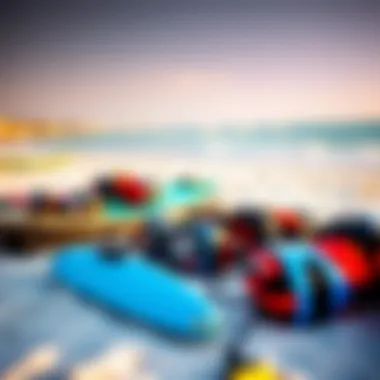
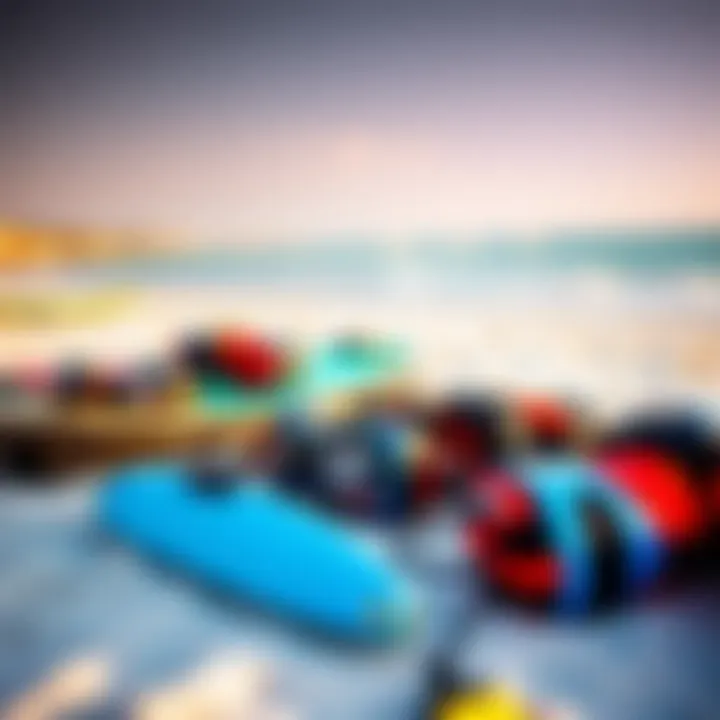
Understanding these aspects of lessons not only prepares you for the learning journey ahead but also sets realistic expectations. Embracing this experience opens the door to a vibrant community waiting to welcome you into the world of kitesurfing.
Choosing the Right School in West Palm Beach
When it comes to embracing kitesurfing, selecting the right school in West Palm Beach is a pivotal step in ensuring not just safety but also the quality of your learning experience. With a wealth of options available, it can be a daunting task for beginners or even seasoned riders looking to refine their skills. The mission is to land yourself in a place that meets your personal learning style and ambitions. Here are a few things to consider:
- Accreditation: Make sure the school has the necessary certifications, such as being accredited by the International Kiteboarding Organization (IKO) or similar entities. This assures you that you are getting skilled instruction in a safe environment.
- Reputation: Read through online reviews and classroom testimonials. Personal experiences of previous students can be invaluable. Remember, a school might boast state-of-the-art equipment, but if the teaching quality is subpar, it’s not worth your time or money.
- Location: Different areas in West Palm Beach offer distinct kitesurfing conditions. Select a school that operates in a location suited to your skill level. Some spots are better for beginners, while others may cater to advanced riders.
- Equipment Availability: Ensure that the school provides high-quality, well-maintained gear. If they offer the latest equipment, it can significantly enhance your experience and learning curve.
Finding a good school can be the difference between a thrilling ride and a frustrating learning process.
Comparison of Local Schools
West Palm Beach boasts a variety of kitesurfing schools, each offering unique programs and teaching approaches. Take a closer look:
- Kiteboarding West Palm Beach: Known for their personalized instruction, they cater to all skill levels. They feature small group sizes, allowing for tailored lessons and a focus on each participant's learning pace.
- Kite Crazy: This school focuses on fun and safety. They offer comprehensive courses featuring experienced instructors who incorporate safety practices into every lesson. Their favorable reviews often spotlight the engaging nature of their approach.
- Kite Surf and Paddle: They provide combo lessons that cover kitesurfing and paddleboarding. It’s a great choice for those looking to explore other water sports alongside kitesurfing. Their strong emphasis on community building often makes new students feel at home right away.
Each school presents its charms—factors like constructive feedback, instructor personality, and added programs can make all the difference.
Instructor Qualifications
The qualifications of instructors are absolutely crucial when looking for a suitable kitesurfing school. Not just anyone can rightly teach the nuanced art of kitesurfing. When evaluating instructors, consider:
- Certifications: Instructors should have robust training credentials from recognized organizations like IKO or similar Certifications. This indicates that they have completed specific training programs and understand the nuances of teaching kitesurfing.
- Experience Level: It's one thing to be able to kitesurf; it's another to teach it effectively. Look for instructors who have substantial teaching experience. Their practical knowledge can provide insights that aren't covered in manuals.
- Communication Skills: An experienced instructor who can explain concepts clearly is invaluable. Great instructors can read the room and modify their teaching methods based on students’ comprehension levels.
- Passion for Teaching: An enthusiastic instructor will often generate enthusiasm in their students. It’s important to be taught by someone who enjoys sharing their love for the sport. Their excitement can make the learning process enjoyable.
Choosing a school is not just about learning to ride the waves, it's about surrounding yourself with knowledgeable instructors who can set you on the right path. By considering these elements, you can make a more informed choice on which kitesurfing school will best suit your needs in sunny West Palm Beach.
Lesson Formats
When diving into kitesurfing, understanding the different formats of lessons is crucial to optimizing your learning experience. The way lessons are structured can significantly impact skill acquisition, confidence building, and overall enjoyment of the sport. Here are some key insights into what to expect with various lesson formats, highlighting how they cater to different needs.
Private vs. Group Lessons
Choosing between private and group lessons can feel like a bit of a tightrope walk. Each format has its own set of advantages and can cater to distinct learning styles.
- Private Lessons:
- Group Lessons:
- One-on-one instruction allows for personalized attention, giving you the chance to progress at your own pace. Instructors can tailor lessons to focus on your specific strengths and weaknesses, ensuring that every minute is maximized for skill development.
- These sessions can often lead to faster learning since the instructor's methods can be adapted directly to your needs. Plus, if you're someone who easily gets distracted or feels self-conscious, this format might just be the key to your success.
- On the flip side, group lessons can provide a camaraderie that many learners find motivating. Sharing the learning experience with peers often leads to a supportive environment.
- While the instruction may be less tailored to individual needs, the group dynamic can help foster confidence—after all, you’ll witness others facing similar challenges. Plus, many schools entice with lower pricing for group sessions, making it an economical choice.
Ultimately, whether to go solo or share the stage with a crowd comes down to your personal style and learning preferences. Think about what might help you more: the focused guidance of a private instructor or the motivational vibes of a group setting.
Online and Remote Learning Options
In our tech-savvy era, online and remote learning have found their way into the kitesurfing world. Though the wind beneath your wings comes from being on the water, finding a strong theoretical foundation is equally important.
- Online Courses:
- Remote Learning with Instructors:
- Many schools now offer online courses covering essential topics such as safety guidelines, equipment basics, and best practices. These digital resources enable you to learn at your own convenience, catching up on material whenever your schedule permits.
- Furthermore, this format is perfect for those who may be hesitant to jump into the ocean immediately. For example, platforms like YouTube have a plethora of kitesurfing tutorials that break down techniques in layman's terms.
- Some instructors have also gotten creative, offering remote training sessions. These sessions provide students with a chance to learn drills or maneuvers through video calls—an innovative way to receive feedback without being physically present with the instructor.
- This option has its limits, of course. You can't practice the actual sport this way, but it certainly can help prepare you mentally for what lies ahead.
In summary, regardless of how you choose to fuel your kitesurfing passions, the advent of online and remote learning provides a wealth of opportunities to prepare you. With a combination of practical lessons and theoretical understanding, you can set sail towards becoming a proficient kitesurfer.
Preparation for Your First Lesson
Preparing for your first kitesurfing lesson is critical. It sets the foundation for a safe and enjoyable experience on the water. Traveling into this exquisite sport without the right preparations can turn an exhilarating adventure into a daunting encounter. As the saying goes, proper preparation prevents poor performance. The same rings true in kitesurfing, where understanding essential elements can uplift your confidence and enhance your learning curve.
Essential Gear and Equipment
The right gear is non-negotiable when kicking off your journey in kitesurfing. Here’s what you'll need:
- Kite: This is the lifeline. Choose the right size depending on your weight and wind conditions. Bigger kites work well in lighter winds while smaller ones are optimal for stronger winds.
- Board: A beginner board is usually wider and more stable, making it easier to balance. You might want to rent first to find out what feels comfortable before investing in your own.
- Harness: A comfortable harness is just like a trusty sidekick. It liberates your arms and helps distribute the kite's power evenly.
- Safety Gear: The importance of safety cannot be overstated. A good impact vest and helmet can seriously protect you from unforeseen mishaps.
- Wetsuit: Depending on the temperature of the water, wearing a wetsuit might be necessary. It keeps you warm and provides an extra layer of protection against possible impacts.
After assessing all this gear, it’s wise to reach out to your lessons provider. They can guide you about what’s included in your session, potentially saving you unnecessary costs.
Physical Fitness and Awareness
Kitesurfing is more than just a thrilling activity; it requires a fair bit of fitness and mental readiness. While you don’t need to be a gym buff, there's a definite advantage to being in shape. Here’s why:
- Endurance: Kitesurfing demands time on the water. Building aerobic fitness enables you to endure longer sessions without breaking a sweat (or too much of it).
- Core Strength: A strong core is vital in maintaining balance on the board. Including exercises like planks and squats can be helpful.
- Flexibility: Increased flexibility through stretching can facilitate smoother movements. This contributes to better control of both your body and the kite.
Awareness of your surroundings is just as important. Pay attention to:
- Wind Direction: Knowing which way the wind blows is crucial to choosing where to start. Knowledge here can save you from a faceplant or a long walk.
- Water Conditions: Waves and currents can differ vastly from spot to spot. Stay sharp and make notes about any potential obstacles, including fellow kitesurfers. Knowing where not to go can sometimes be as critical as knowing where to go.
Preparation is a process, not just a checklist. Embrace the journey and allow each piece of knowledge to fuel your excitement. As you step into this thrilling endeavor, remember that every kite you fly is a step closer to mastering the art of kitesurfing.
Safety Considerations
When diving into kitesurfing, one cannot overlook the importance of safety. Engaging in this exhilarating sport comes with its fair share of risks, but with the right precautions and a sound understanding of safety guidelines, one can enjoy kitesurfing without jeopardizing their well-being. In West Palm Beach, where the conditions can change rapidly, being well-prepared ensures not only personal safety but also enhances the overall kitesurfing experience.
Understanding the Risks
Kitesurfing is often regarded as an adrenaline rush, but it is crucial to recognize that the thrill comes with certain inherent hazards. Some common risks involve:
- Environmental Factors: Ocean currents, weather changes, and wind gusts can swiftly alter kitesurfing conditions. A momentary lapse in judgment or misreading these elements can lead to falls or accidents.
- Equipment Failure: No piece of gear is infallible. Improper setup or wear-and-tear on kites can cause them to malfunction. Always assess your equipment before hitting the water to mitigate these risks.
- Collisions: It's not uncommon to share the water with other water sports enthusiasts. Not keeping a safe distance can result in unfortunate clashes with other kitesurfers, boats, or personal watercraft.
- Personal Misjudgment: Adrenaline can cloud one’s judgment. Overestimating one’s skills or pushing boundaries can lead to unnecessary accidents.
Understanding these risks will help you stay alert and focused, making your time on the water more enjoyable and safe.
Safety Equipment Recommendations
Investing in good safety gear can be the difference between a thrilling day and a fateful incident. Knowing what to wear and what to have on hand is essential for a safe kitesurfing outing. Here’s a list of recommended safety equipment:
- Safety Harness: A well-fitting safety harness is essential to comfortably secure the kite and keep the body safe during crashes.
- Life Vest: Wearing a buoyancy aid can provide extra security in rough waters, especially for beginners who may struggle with self-rescue.
- Helmet: Protecting your head is non-negotiable. A certified water sports helmet should be included as part of your gear.
- Safety Knife: This tool can be a lifesaver in emergencies. It’s used to cut lines if you become entangled, ensuring a quick end to potentially dangerous situations.
- Leashes: Ensure that your board is attached to you with a reliable leash. This prevents losing your board to the waves and makes it easier to retrieve.
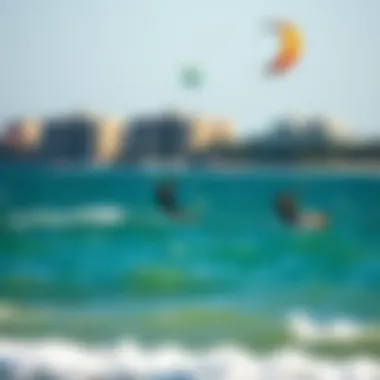
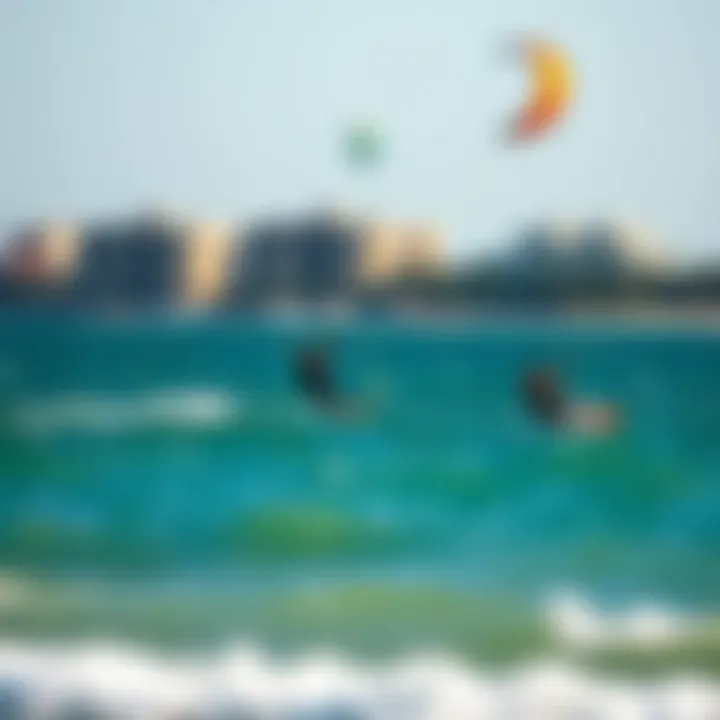
Emphasizing safety isn't just a checklist; it’s an ongoing conversation among the kitesurfing community. Kitesurfing schools in West Palm Beach often place great importance on these elements in their training sessions. Learning how to recognize and respond to hazards is not only fundamental but also enhances your confidence on the water.
"Safety first – because without it, there's no fun in the sport."
Incorporate these safety considerations into your kitesurfing routine. It will not only safeguard your experience but will also contribute to a vibrant, responsible kitesurfing culture in West Palm Beach.
Locational Features of West Palm Beach for Kitesurfing
West Palm Beach is not merely a geographic location; it is a kitesurfer's paradise where optimizing conditions and stunning landscapes come together. With its warm waters and consistent wind patterns, this coastal haven provides a unique experience for both novice and seasoned kiteboarders. To effectively harness the essence of kitesurfing here, understanding the locational features is crucial.
Best Beaches and Conditions
When discussing the best beaches for kitesurfing in West Palm Beach, the coastline boasts several prime spots. Enjoying clear blue waters and stretches of sandy beaches, locations such as Singer Island, Lake Worth Beach, and Jupiter Beach stand out. Singer Island, in particular, has favorable conditions with its shallow waters that are perfect for beginners, while more experienced riders might prefer the waves and challenges found at Jupiter Beach.
The prevailing weather conditions also play a significant role. The area enjoys mild temperatures year-round, with summer months from June to August being the warmest. However, it’s the winter months that bring steady trade winds perfect for kitesurfing. Typically, the wind strength hovers between 12 to 30 knots, offering ideal conditions for various skill levels. Having a keen eye on the kiteboarding-specific weather reports can help you plan your sessions effectively, allowing you to catch the best wind.
"Kiteboarders often say that the magic happens when you find the right beach with the right wind on an unforgettable day."
Seasonal Wind Patterns
Understanding seasonal wind patterns is key to maximizing your time on the water. In West Palm Beach, the wind is predominantly east-northeast, providing consistent breezes ideal for kitesurfing. The winter season, from November to March, typically boasts the most reliable wind conditions. These months not only offer steady winds but also cooler temperatures, making it comfortable for longer sessions on the water.
Conversely, during the summer, the wind might be a bit trickier to predict because of the influence of storm systems. While afternoons may sometimes bring thermal winds, they can also result in unpredictable gusts. Therefore, it’s advisable to check local weather apps or websites that focus on kitesurfing conditions more than general weather reports. Particularly, sites like Windy or KiteMap provide special forecasts tailored for kitesurfing.
In summary, the locational features of West Palm Beach represent a confluence of stunning geography and favorable wind conditions, allowing kiteboarders to immerse themselves in a truly thrilling experience. By embracing the unique attributes of various beaches and becoming attuned to seasonal wind patterns, you pave the way for unforgettable kitesurfing adventures on the breathtaking waters of Florida.
Post-Lesson Practices
After taking kitesurfing lessons in West Palm Beach, it’s key to have a post-lesson game plan. This phase is often overlooked by many beginners, but it holds the potential to significantly boost your skills and confidence on the water. Focusing on post-lesson practices can enhance your learning experience and accelerate your progression in kitesurfing.
Continuing Skill Development
Once the lessons are done, the real journey kicks off. To keep the ball rolling, you should practice what you learned consistently. Skills like launching, landing, and controlling the kite can benefit from repetition.
- Seek out practice days: Regular time on the water helps solidify your skills. You might consider hitting the beach after your lessons, even if conditions aren’t perfect. Every session counts towards improvement.
- Set specific goals: Define what you want to achieve in your next session. Maybe it’s mastering a particular turn or improving your jump. Having clear goals can keep your practice focused.
- Use video analysis: Recording your practice lets you see your form. It can pinpoint areas that need work that you might not notice while you’re riding.
- Enroll in advanced classes: As your skills develop, joining advanced sessions or clinics can expose you to new techniques and challenges.
By keeping your passion alive, you not only maintain your skills but also build upon them, which adds depth to your kitesurfing journey.
Building a Community
Connecting with fellow kitesurfers can greatly enrich your experience.
- Meet locals and other learners: The kitesurfing community in West Palm Beach is vibrant. Engaging with others, sharing experiences, and swapping tips can foster camaraderie. Fellow surfers often become friends on and off the water.
- Participate in group events: Look for kitesurfing meet-ups, competitions, or social gatherings. These events are terrific for networking and spotting new learning opportunities. Plus, you might catch wind of local spots where you can practice or events you wouldn’t want to miss.
- Utilize social media: Follow groups and pages on platforms like Facebook or Reddit to stay updated on events, gear swaps, and local surf reports.
- "The only bad session is the one that doesn’t happen." This mantra is shared widely in the kitesurfing community, reflecting the spirit of continuous engagement.
Through community interaction, you not only improve your skills but also nurture friendships and a sense of belonging in the kitesurfing scene. Building this support network can provide encouragement, advice, and an outlet to share your passion.
Equipment Maintenance and Care
Taking care of your kitesurfing gear is not just about preserving your investment; it’s a vital part of ensuring your safety and performance on the water. Proper maintenance encompasses routine checks and careful storage methods, both of which can extend the life of your equipment significantly. A well-maintained kit can enhance your experience, whether you are a novice learning the ropes or a seasoned pro chaining together those hair-raising tricks.
Routine Checks for Gear
Regular inspections are essential to keep your kitesurfing equipment in tip-top shape. These checks should be as routine as your pre-kite warm-up. Here are some key items to consider during your checks:
- Kite Fabric and Stitching: Examine for tears or abrasions. Air pressure can exacerbate weaknesses, making an unnoticed hole a ticking time bomb.
- Lines and Leaders: Check for fraying or signs of wear. Using a damaged line can result in a catastrophic failure when you least expect it.
- Harness Components: Ensure all buckles and straps are functioning correctly. A faulty harness can lead to accidents, especially in high winds.
Inspecting your gear isn’t just a checklist; it’s an opportunity to familiarize yourself with its condition. After all, there’s nothing worse than heading out, only to have a gear malfunction cut your session short.
"An ounce of prevention is worth a pound of cure.” – Benjamin Franklin
Storage Practices
Once you’re back from a day on the water, how you store your kitesurfing gear matters just as much as how you maintain it. Poor storage can lead to premature wear or, worse, create conditions ripe for mold growth. Here are some useful practices:
- Rinse off Saltwater: Salt can corrode both fabric and metal parts, so a quick rinse with fresh water is essential to remove any residual salt.
- Dry Completely: Ensure your kite and other equipment are as dry as a bone before packing it away. This helps to prevent mildew and damage.
- Store in a Cool, Dry Place: Avoid leaving your gear in direct sunlight or very humid areas. A temperature-controlled closet or a dedicated storage bag can work wonders for keeping your gear safe.
In wrapping up, remember that kitesurfing is an exhilarating sport but comes with its share of risks. Regular maintenance and smart storage practices can not only enhance your gear's longevity but also ensure you're safe on those waves. Investing time in caring for your equipment will pay off, leading to many more thrilling kitesurfing sessions in West Palm Beach.
For further insights into kitesurfing equipment and maintenance tips, check out Wikipedia on Kitesurfing or visit Reddit's Kitesurfing Community for fellow enthusiasts' experiences.
Environmental Considerations
Understanding the impact of kitesurfing on the environment is fundamental for both the sport's longevity and the preservation of the natural habitats around West Palm Beach. As one delves into the world of kitesurfing, the thrill of riding waves and harnessing the wind should not overshadow the responsibilities tied to sustaining the local ecosystem. Prioritizing environmental awareness helps in action steps that can contribute to kitesurfing's continued appeal among enthusiasts while ensuring that beaches, waterways, and marine life remain unharmed.
Sustainable Kitesurfing Practices
Sustainability in kitesurfing encompasses various practices that promote ecological balance and minimize harm to the environment. Some key sustainable practices include:
- Eco-Friendly Gear Selection: Opting for kites and boards constructed from sustainable materials can significantly lessen one's carbon footprint.
- Proper Waste Disposal: It’s crucial to leave no trace behind. Whether it be snack wrappers or broken equipment, responsible disposal or recycling can limit pollution in our oceans and beaches.
- Respecting Local Regulations: Every region has its own set of rules regarding kitesurfing, which typically include designated areas for the sport. Following these not only ensures safety but also protects delicate ecosystems from disruption.
- Waste Water Mitigation: When emerging from the water, avoid washing gear or yourself in waterways. This can introduce unwanted chemicals back into natural habitats.
Practicing sustainable kitesurfing is about embracing a mindset that blends enjoyment with stewardship. It’s about finding that sweet spot between thrill-seeking and environmental respect.
Local Wildlife Awareness
Being attuned to local wildlife can greatly enhance the kitesurfing experience while minimizing human impact. Understanding the marine species and bird populations that call West Palm Beach home is essential.
Some practical points for kitesurfers include:
- Bird Nesting Areas: During certain times of the year, some beaches may serve as nesting grounds for birds. Recognizing these areas and keeping a respectful distance can ensure their reproductive success.
- Marine Life: Keeping an eye on marine animals, such as dolphins or sea turtles, is another essential aspect. If sightings are made, avoiding their direct vicinity shows respect for their habitats.
- Education: Familiarizing oneself with local fauna through workshops or conservation efforts can deepen the bond between kitesurfers and their environment. Participating in community cleanups fosters a sense of responsibility and connection to local natural surroundings.
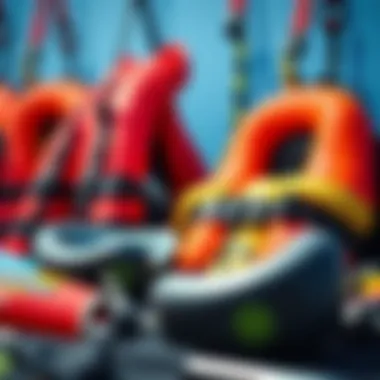
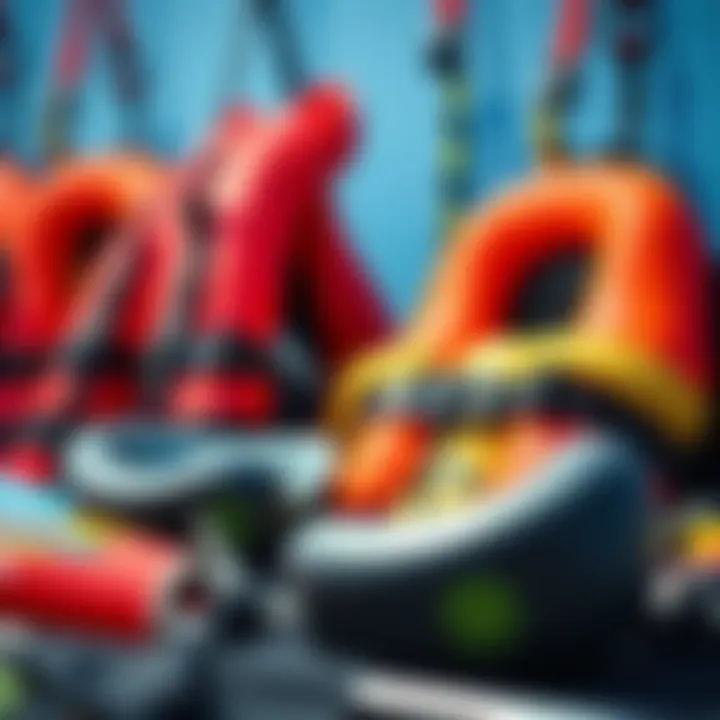
“Kitesurfing is not just about the thrill; it's about ensuring our oceans remain vibrant for generations to come.”
Ultimately, environmental considerations in kitesurfing are not merely an afterthought but a guiding principle that all enthusiasts should adopt. Balancing the allure of the sport with proactive ecological practices not only protects West Palm Beach’s beautiful waters but also fortifies a sustainable culture within the kitesurfing community.
Events and Competitions in West Palm Beach
As kitesurfing continues to grow in popularity, events and competitions in West Palm Beach serve as a vibrant focal point for the community. Not only do these gatherings showcase skill and athleticism, but they also foster a spirit of camaraderie among participants. In a place where the winds meet the waves with almost poetic harmony, it makes perfect sense that kitesurfing events become a way for both locals and visitors to come together, share experiences, and push the boundaries of the sport.
Organizing and Participating
The organization of kitesurfing events in West Palm Beach often revolves around regional wind patterns, taking advantage of the most favorable conditions. Local schools and organizations might team up to put together competitions that cater to various skill levels. Whether you’re a seasoned pro or just starting out, there’s usually something on the calendar that suits your abilities.
When taking part in such an event, it’s essential to familiarize yourself with several factors:
- Registration: Many events require participants to register in advance. This can often be done online. Follow their page on social media to get the latest updates.
- Requirements: Make sure you understand any gear requirements and safety regulations. Different events might have differing stipulations regarding kites and boards.
- Practice: Participating in local practice days before the event can help you gain familiarity with the course and conditions. Consider spending time at well-known spots like the Lake Worth Lagoon where many competitions take place.
Competing isn’t just about showcasing your skills; it also presents a chance to learn. Watch experienced riders and observe their tricks. Even a minor slip-up during a heat can provide valuable lessons for future attempts.
Connecting with Other Enthusiasts
Events are more than just competitions; they’re social gatherings that unite like-minded individuals. Connecting with other kitesurfers in West Palm Beach can lead to friendships that last a lifetime. During these events, you’ll frequently find a mix of well-established riders and newbies, creating a unique learning environment.
Attending events can bring myriad opportunities:
- Networking: Meet potential riding buddies, instructors, and brands. You might find someone willing to share a ride to a more secluded kitesurfing spot, or who’s interested in teaching you a few new tricks.
- Knowledge Sharing: Engaging in discussions about techniques, gear, or weather conditions can deepen your understanding of the sport. Many surfers are happy to share their insights and experiences.
- Community Spirit: The enthusiasm and energy at these events are contagious. You'll find clubs that host regular meet-ups through social media, so get involved and participate in local forums.
"The best part about kitesurfing events is not just the competition; it's the friends you make along the way."
Cost and Investment in Learning
When it comes to kitesurfing, understanding the cost and investment involved is crucial for anyone looking to dive into this thrilling sport. It’s not just about the thrill of riding the wind; it’s also about being prepared financially for the journey ahead. This section aims to highlight key aspects of costs involved in lessons and gear, ensuring that new kitesurfers can make informed decisions.
Understanding Lesson Fees
Kitesurfing lessons can vary quite a bit in price, depending on a few factors such as the type of lesson, the experience level of the instructor, and the duration of the class. Typically, a private lesson in West Palm Beach may set you back between $100 to $200 for an hour. Meanwhile, group lessons can be more economical, often falling in the range of $75 to $150 per person.
However, don't let the prices scare you off. Investing in quality instruction often pays off in the long run. Here are some critical points to consider:
- Experience of Instructors: High-quality schools often employ instructors with years of experience and certifications from recognized kitesurfing associations. Paying a bit more for seasoned professionals can lead to quicker learning and safer practices.
- Equipment Inclusion: A school that includes rental equipment in the lesson fee can save you extra bucks. This way, you’re not buying expensive gear just to test the waters.
- Local Reputation: Sometimes, investing in a well-reviewed school can greatly enhance your experience. Feel free to read up on reviews on platforms like Reddit or Facebook, where real customers share their experiences.
In general, this investment in lessons can help you grasp the fundamentals effectively, making your initial kitesurfing experience much smoother.
Long-Term Equipment Investments
Once you've got the hang of the basics, the next step often involves investing in your own gear. Long-term equipment investments are crucial not just for performance but also for safety and enjoyment. Here’s what you should consider:
- Initial Costs: Expect to shell out anywhere from $1,500 to $3,000 for a complete setup, including a kite, board, harness, and safety gear. This might feel steep, but think of it as a long-term investment.
- Quality Over Cost: You might find cheaper options at big retailers or second-hand markets, but the quality may vary widely. Equipment that meets safety standards is essential for both performance and peace of mind. Look for brands like Duotone or Slingshot, which are known for durable products.
- Maintenance and Upgrades: As you build your skills, consider budget for upgrades in gear. Kites, for instance, are often rated for different wind conditions, so you may find yourself needing a second or third kite to optimize your experience as your skills grow.
"Investing in quality equipment not only elevates your performance but keeps the thrill alive for seasons to come."
Advanced Kitesurfing Techniques
Mastering the basic skills of kitesurfing is just the beginning. Once you have a handle on the essentials, it’s time to explore advanced kitesurfing techniques. These skills can elevate your riding experience, allowing you to express yourself more freely on the water and push your limits. From impressive aerial maneuvers to unique stylistic choices, delving into advanced techniques adds both excitement and depth to your kitesurfing journey.
Tricks and Maneuvers
Tricks and maneuvers are the bread and butter of advanced kitesurfing. They not only showcase your skills but also define your personal style on the water. Here are some key considerations when learning new tricks:
- Safety First: Before attempting any trick, ensure you’re comfortable with your current skill level. Familiarize yourself with safety protocols and spotters, if possible.
- Break it Down: Rather than trying to master a complex trick all at once, break it down into manageable components. For instance, when attempting a jump, practice the pop first before adding rotation or grabs.
- Body Positioning: Understanding body mechanics is crucial. Your stance and weight distribution play essential roles in executing smooth transitions and successful landings.
- Use Visual Aids: Videos of professional kitesurfers can serve as helpful guides. Watching how they execute certain tricks can clarify the techniques you might want to try.
Some common tricks include the following:
- Kite Loop: A thrilling move where the kite is steered in a circle, generating extra pull and lift.
- Front Roll: A forward rotation in mid-air, showcasing both style and control.
- Back Roll: Similar to the front roll, but rotates backwards, presenting an elegant flip that can impress onlookers.
Each of these tricks offers unique challenges and rewards, and with consistent practice, they'll become part of your skillset.
Kitesurfing Styles
Kitesurfing isn’t just one thing; it encompasses various styles that cater to different preferences and levels of adventure:
- Freestyle: This is all about tricks and creativity. Freestyle riders focus on jumps, spins, and innovative moves, making their runs highly descriptive.
- Freeride: Merging power and speed, freeride kitesurfers traverse waters with grace, enjoying scenic rides without the need for complex tricks.
- Wave Riding: If you’re drawn to the ocean's natural elements, wave riding may appeal to you. This style emphasizes riding the waves and using them for lifts and tricks, alongside the kite's pull.
- Racing: For those who thrive on competition, racing kitesurfing lends itself to speed and strategy on specially designed boards. Here, precision and timing are vital.
Exploring different kitesurfing styles not only helps you find what suits you best but also connects you with a broader community of enthusiastic riders. Each style has its own set of rules, techniques, and unique vibes, which enriches the overall kiting experience.
"Advanced kitesurfing techniques are not just about the tricks - they're a language of expression on the water, telling your story of adventure and personal style."
Concluding Thoughts
Kitesurfing in West Palm Beach is more than just a sport; it is an experience that intertwines the thrill of riding the waves with the gentle push of the wind. As we reflect on the journey through the numerous aspects of kitesurfing lessons, it becomes clear that these sessions provide a sturdy foundation for both novices and those looking to sharpen their skills. The skillful instruction of qualified instructors not only enhances personal safety but also accelerates the learning curve, allowing individuals to progress more efficiently.
Reflecting on Your Kitesurfing Journey
When considering your personal kitesurfing journey, take a moment to ponder how far you’ve come since that first lesson. Each gust of wind carries memories of triumph and challenges, forming the chapters of your unique story.
- Perhaps your first awkward attempts at balancing on the board made you laugh and cringe at the same time.
- You might remember that day when the wind was just right, and you finally caught air.
Reflecting on these moments reinforces the idea that kitesurfing is a continuous journey of self-improvement, fluidity, and connection with nature. It encourages you to set new goals—learning new tricks, exploring different spots, or even joining competitions. Furthermore, every session on the water enhances both physical fitness and mental resilience, melding into a holistic exploratory experience. Each ride is not just about the thrill but also about the harmony created with the ocean's rhythm.
The Future of Kitesurfing in West Palm Beach
As we gaze into the future of kitesurfing in West Palm Beach, the horizon appears full of potential. With increasing popularity, one can expect more innovative gear and advancements in teaching methodologies that cater to diverse levels of expertise. Additionally, the local community will continue to grow, emphasizing sustainability as part of the culture, thus ensuring the preservation of natural environments
- Emerging technology like remote coaching through video analysis can redefine skill acquisition.
- Awareness programs might focus on protecting local ecosystems, enabling kitesurfers to engage responsibly.
Moreover, events and competitions promise to flourish, fostering a sense of camaraderie among kiteboarders. Networking among enthusiasts and instructors can pave the way for collaborative efforts that amplify the experience for all. Enthusiasts should remain informed and engaged through platforms like Reddit or local community boards to connect with others and stay updated on events or workshops.
In summary, the future looks bright, and with it, the ongoing journey of kitesurfing has significant implications for personal development, community engagement, and environmental stewardship.
"Kitesurfing teaches us more than just agility and balance; it enriches our respect for nature and nurtures lasting friendships in the heart of the sport."
Thus, embracing this journey opens the door to endless possibilities that await in the vibrant waters of West Palm Beach.















